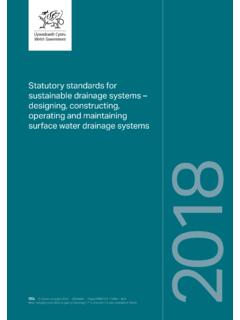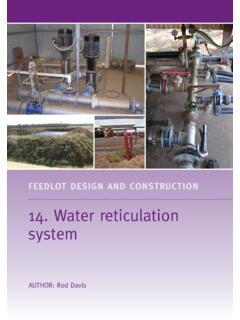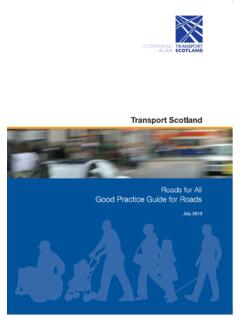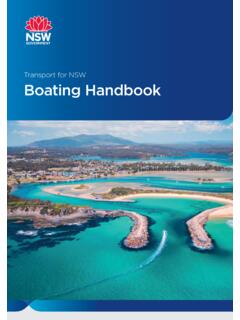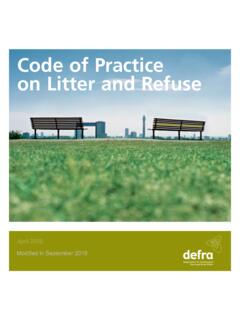Transcription of Guidance Notes - Highways Statutory Duties and Vested …
1 Page 1 of 7 Guidance Notes JULY 2015 If you are unsure about anything within these Notes then please contact the Derbyshire County Council Highways division on the details at the end of this document. The County Council is responsible for maintaining Highways across Derbyshire at public expense. Therefore the County Council is termed a highway Authority. Highways England are also termed a highway Authority and are responsible for maintaining the Major trunk Roads across Derbyshire. A reference to a highway in these Guidance Notes includes all public rights of way that are maintainable at public expense.
2 The County Council are responsible for the installation, operation and maintenance of highway drainage infrastructure, which falls within the adopted highway curtilage in Derbyshire (refer to Figure 1). Figure 1 Maintenance responsibilities for highway and ditches/watercourse Ditches that run alongside a highway generally do not form part of the highway (since they do not assist the free passage along it) and remain the Guidance Notes : Highways Statutory Duties AND Vested POWERS Page 2 of 7 Guidance Notes JULY 2015 responsibility of the landowner or occupier (please refer to Figure 1). Common law places a duty of the owner of land adjacent to a highway to maintain any ditches which function as natural drainage for the land and also as part of the highway drainage (please refer to Figure 1).
3 However, where the ditches have been dedicated as forming part of the highway , or where the ditch was constructed for the purpose of draining the highway , then the ditch will form part of the highway and may be the responsibility of the highway Authority. highway drains are designed to accept surface water runoff from roads and footpaths within the highway curtilage. The County Council have a right to drain the highway to remove a nuisance ( water on the surface) and can connect into a nearby watercourse. In this instance the County Council would however only be responsible for the lateral connection into the watercourse, which would be in place to drain the highway . Where flooding on a highway is caused by another person ( an adjoining landowner), the County Council can take action against the person responsible.
4 However, where the flooding is caused by inadequate highway drainage, the County Council may be liable for causing a nuisance. Please refer to the Riparian Landownership Guidance Notes for further information. Duties and Vested Powers under the Highways Act The following Duties and Vested powers, under which the authority may act, are described in reference to the Highways Act 1980 (unless described otherwise). (The information contained below is by no means an exhaustive list of all the Duties placed upon the County Council as a highway Authority but aims to provide a high level overview of some of the key sections contained within the relevant legislation.) Duties for Provision and Care Highways Act 1980 Section Title Section Description Section 41 Duty to maintain Highways maintainable at public expense.
5 Special defense in action against a highway authority for damages for non-repair of This duty has been transposed into statute by virtue of Section 41 of the Highways Act 1980. The duty extends to all Highways maintainable at the public expense, with the exception of trunk roads. The Section 41 duty is not absolute. The Highways Authority must take such care in all the circumstances as is reasonably required to ensure the highway is not dangerous for traffic. What is reasonable will depend on a number of factors, including those set out in Section 58 (defence against action for non-repair of Page 3 of 7 Guidance Notes JULY 2015 highway highway ): the character of the highway and traffic; the standard of maintenance appropriate for a highway of that character and used by that traffic; the state of repair a reasonable person would expect to find the highway ; whether the highway Authority knew that the condition of the highway was likely to cause danger; and where.
6 The highway Authority could not have reasonably have been expected to repair that part of the highway before the incident occurred, what warning notices of its condition had been displayed. The Section 41 duty includes a duty to provide an adequate drainage system and keep the highway free from flooding. Section 41 - The way in which the County Council manage our legal duty is via the area Highways teams providing and maintain appropriate/adequate drainage within the highway curtilage. Section 103 Provision of posts to indicate depth of flood water On Highways liable to flooding to a considerable depth, the highway Authority has a duty to provide graduated posts or stones indicating the depth of water covering the highway where it is considered necessary or desirable.
7 Section 130 Protection of public rights Section 130 imposes a general duty for the highway Authority to assert and protect the rights of the public to use and enjoy the highway . In order to fulfil this duty, the Highways Authority has a responsibility to remove encroachments and obstructions of the highway . Flooding is classified as an obstruction. Section 103 At times of adverse weather the highway Division is confronted with a demand on service for which well exceeds its capability and resources. Due to this the highway Division prioritise their response based on risk matrix, covering things such as risk to road users and impact upon critical infrastructure. Section 150 Duty to remove snow, soil etc.
8 From highway This section imposes a duty of the highway Authority to remove an obstruction arisen from the accumulation of snow or from the falling down of banks on the side of the highway , or from any other cause. Section 264 Vesting of drains etc. of certain roads By virtue of Section 264, drains which belong to a road for which the County Council is the highway Authority, have a Vested right to use any other drains or sewers where they are and have been used for purposes connected to the drainage of the road . Note, however, Page 4 of 7 Guidance Notes JULY 2015 that private drains do not lose their status by being used also for draining a highway .
9 Public sewers are Vested in the water companies within Derbyshire for whom are as follows; Severn Trent Water, United Utilities and Yorkshire Water. Section 339 Saving for works etc. of drainage authorities etc This section requires a highway Authority to obtain the consent of the authority s Flood Risk Management Team before any watercourse is used, interfered with, or before works are carried out on any watercourse or drainage works. The highway Authority must obtain consent from the Environment Agency if the waterbody is designated as a Main River. Powers available as highway Authority If a person causes a nuisance ( anything that obstructs the highway or makes it dangerous) the highway Authority have a permissive power to prosecute that person (causing a nuisance in the highway is a common law offence) or take action in the civil courts for an injunction and/or damages.
10 Generally, a prosecution for nuisance will only be considered if there is no suitable Statutory provision under which to take action. Highways Act 1980 Section Title Section Description Section 137 Penalty for willful obstruction If a person, without lawful authority or excuse, wilfully obstructs the free passage along a highway he/she is guilty of an offence and liable to a fine. Section 137 This section can relate to a third party wilfully allowing the transfer of water from their land ownership on to the public highway , thus causing an obstruction to the free passage of the highway . This permissive power is exercised at the discretion of the Highways Division. Section 149 Removal of things so deposited on Highways as to be a nuisance etc If anything is so deposited on a highway as to constitute a nuisance, the highway Authority may by notice require the person who deposited it there to remove it forthwith and in default, the highway Authority can remove the nuisance and recover the costs.




